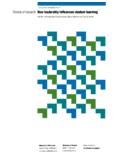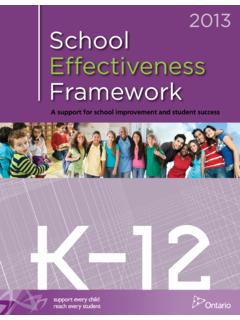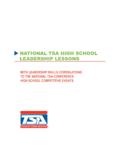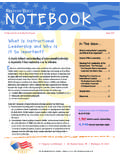Transcription of Differentiating Instruction in Response to Student ...
1 Differentiating Instruction in Response to Student Readiness, Interest, and LearningProfile in academically Diverse Classrooms: a review of LiteratureCarol Ann Tomlinson, Catherine Brighton, HollyHertberg, Carolyn M. Callahan, Tonya R. Moon, Kay Brimijoin, Lynda A. Conover, & Timothy ReynoldsBoth the current school reform and standards movements call for enhanced qualityof Instruction for all learners. Recent emphases on heterogeneity, special educationinclusion, and reduction in out-of-class services for gifted learners, combined withescalations in cultural diversity in classrooms, make the challenge of serving acad-emically diverse learners in regular classrooms seem an inevitable part of a teacher srole. Nonetheless, indications are that most teachers make few proactive modifica-tions based on learner variance. This review of literature examines a need for dif-ferentiated or academically responsive Instruction . It provides support in theoryand research for Differentiating Instruction based on a model of addressing studentreadiness, interest, and learning profile for a broad range of learners in mixed-abilityclassroom settings.
2 Introduction: A Rationale for Differentiating InstructionToday s classrooms are typified by academic diversity (Darling-Hammond, Wise, & Klein, 1999; Meier, 1995). Seated side by sidein classrooms that still harbor a myth of homogeneity by virtue ofchronological age are students with identified learning problems;Carol Ann Tomlinson is Professor of Educational Leadership, Foundations, andPolicy at the University of Virginia, Charlottesville. Catherine Brighton is AssistantProfessor of Educational Leadership, Foundations, and Policy at the University ofVirginia, Charlottesville. Holly Hertberg is Assistant Professor of EducationalLeadership, Foundations, and Policy at the University of Virginia, M. Callahan is Professor of Educational Leadership, Foundations, and Policyat the University of Virginia, Charlottesville. Tonya R. Moon is Associate Professorof Educational Leadership, Foundations, and Policy at the University of Virginia,Charlottesville. Kay Brimijoin is Assistant Professor of Education at Sweet BriarCollege, Sweet Briar, VA.
3 Lynda A. Conover is Assistant Professor of SpecialEducation at Western Illinois University, Macomb. Timothy Reynolds is Departmentof Education Chair and Assistant Professor at Roanoke College, Roanoke, for the Education of the Gifted. Vol. 27, No. 2/3, 2003, pp. 119 2003 The Association for the Gifted, Reston, VA for the Education of the Gifted120highly advanced learners; students whose first language is notEnglish; students who underachieve for a complex array of reasons; students from broadly diverse cultures, economic backgrounds, orboth; students of both genders; motivated and unmotivated stu-dents; students who fit two or three of these categories; studentswho fall closer to the template of grade-level expectations andnorms; and students of widely varying interests and preferredmodes of learning. By 2035, students of color will be a majority inour schools, with increasing populations of children of immigrantand migrant families expanding the presence of cultural diversity inschools.
4 Half of all children will live in single-parent homes atsome time during their school years (Sapon-Shevin, 2000/2001).These demographic realities are intensified by (a) an emphasis ondetracking to promote educational equity for students who mightotherwise find themselves schooled in low-expectations environ-ments, (b) an emphasis on mainstreaming of students with specialeducation needs, (c) a reduction of special programs for gifted learn-ers (Lou et al., 1996; Sapon-Shevin, 2000/2001), and (d) intent toreduce segregation of students with reading problems and toenhance literacy Instruction in the regular classroom for all learn-ers (Allington, 2003). Such evolutions leave teachers with the needto address learner variance in the regular classroom , rather thanthrough organizational arrangements (Jackson & Davis, 2000;Stradling & Saunders, 1993) that have often served to relieve theclassroom teacher of primary responsibility for attending to theneeds of students who diverge markedly from the norm.
5 Thus,throughout the literature of the current school reform movement isa call for teachers to adjust curriculum, materials, and support toensure that each Student has equity of access to high-quality learn-ing (Darling-Hammond et al., 1999; Ducette, Sewell, & Shapiro,1996; Gamoran & Weinstein, 1995; Schoenfeld, 1999).While heterogeneous Instruction is attractive because it addressesequity of opportunity for a broad range of learners, mixed-ability class-rooms are likely to fall short of their promise unless teachers addressthe learner variance such contexts imply (Gamoran & Weinstein,1995). In such settings, equality of opportunity becomes a reality onlywhen students receive Instruction suited to their varied readiness lev-els, interests, and learning preferences, thus enabling them to maxi-mize the opportunity for growth (McLaughlin & Talbert, 1993). Even when special pull-out services, such as reading, English asa second language, gifted education, or special education, areavail-able for identified students , it is likely that most of these learnerswill still spend the bulk of their school careers in regular class-Differentiation: A Literature Review121rooms.
6 Further, even in more homogeneous settings, such as spe-cial education resource rooms, honors classes, and languageresource rooms, it is evident that the range of Student experience,competence, and motivation makes these settings far less homoge-neous than their labels imply (Gamoran & Weinstein, 1995).It is a reasonable hypothesis that a current interest in what iscalled differentiated Instruction is due to a degree of academicdiversity that teachers simply can no longer ignore. If, indeed, it isthe goal of the teacher to ensure that every Student learns effec-tively and with a sense of satisfaction, this mosaic of students pre-sents teachers with complex and difficult pedagogical dilemmas(Lou et al., 1996). Nonetheless, it would seem inevitable thattoday s schools reflect the reality that society is transforming itself;to respond appropriately, classrooms must be places where rigorousintellectual requirements characterize the curriculum, each stu-dent is known well and taught with appropriate means, each stu-dent learns well, and fidelity to individuals and community is ahallmark (Mehlinger, 1995).
7 It may be that educators no longerhave a legitimate choice about whetherto respond to the academi-cally diverse populations in most classrooms; rather, they can onlydecide howto respond (Sizer, 1985; Stradling & Saunders, 1993).As a transformation in society and schools evolves, effectiveteachers in contemporary classrooms will have to learn to developclassroom routines that attend to, rather than ignore, learner vari-ance in readiness, interest, and learning profile . Such routines maybereferred to as Differentiating curriculum and is a pedagogical, rather than an organizational,approach (Stradling & Saunders, 1993). One way of conceiving dif-ferentiation is modification of teaching and learning routines toaddress a broad range of learners readiness levels, interests, andmodes of learning (Tomlinson, 1999, 2001). Differentiation can bedefined as an approach to teaching in which teachers proactivelymodify curricula, teaching methods, resources, learning activities,and Student products to address the diverse needs of individual stu-dents and small groups of students to maximize the learning oppor-tunity for each Student in a classroom (Bearne, 1996; Tomlinson,1999).
8 Current State of the Art With Learner VarianceBoth the relative newness of the critical mass of diverse learners inregular classrooms and the complexity of a teacher s role inJournal for the Education of the Gifted122addressing their needs are underscored by research suggesting thatmost teachers still do little to adjust their Instruction in ways thateffectively reach out to academically diverse populations. Studiesvary in reports of the importance that teachers place on attendingto academic diversity in classrooms. Asurvey of high school teachers (Hootstein, 1998) found 90%responding that addressing academic differences is important orvery important. By contrast, 50% of respondents to a nationwidesurvey of middle school teachers said they did not differentiateinstruction based on readiness, interest, or learning profile becausethey saw no need to do so (Moon, Tomlinson, & Callahan, 1995).General education teachers may also reject adapting Instruction forindividual learner needs because they feel doing so calls attentionto Student differences (Schumm & Vaughn, 1995); they feel it is nottheir job to do so (Schumm & Vaughn, 1995); they are unaware oflearner needs (Schumm & Vaughn, 1992, 1995); they believe specialtreatment is poor preparation for a tough world that does not pro-vide special treatment (Schumm & Vaughn, 1995); or, in the case ofadvanced learners, because teachers do not feel students need adap-tations (Tomlinson, 1995) because teachers do not know how tomodify the curriculum for students whose proficiencies extendbeyond those prescribed by grade-level curricula, standards docu-ments, or both (Callahan, Tomlinson, Moon, Brighton, & Hertberg,2003; Hertberg, 2003).
9 It appears that teachers are more likely tofind adaptations for learner variance to be more desirable than fea-sible (Schumm & Vaughn, 1991). Even when teachers express sup-port for inclusive classrooms, they are likely to plan for whole-classinstruction (Morocco, Riley, Gordon, & Howard, 1996).When teachers haveattempted differentiation, it has often beenused in ways that are limited and ineffective (Schumm et al., 1995;Stradling & Saunders, 1993). Modifications are likely to be impro-visational or reactive, rather than preplanned or proactive(Hootstein, 1998; McIntosh, Vaughn, Schumm, Haager, & Lee,1994; Schumm & Vaughn, 1992, 1995; Tomlinson, 1995). Teachersseem particularly resistant to adapting or modifying materials,planning lessons for individuals, and changing evaluation proce-dures (Johnsen, Haensly, Ryser, & Ford, 2002; Schumm & Vaughn,1995; Vaughn & Schumm, 1994). Appropriate Response to learnervariance is also impeded by Instruction in which understanding issacrificed to coverage and where teachers have not identified keyconcepts, ideas, and skills that would serve as a solid framework formodifications (Schumm & Vaughn, 1995; Tomlinson, Callahan,Tomchin, et al.)
10 , 1997; Vaughn & Schumm, 1994). High-stakes test-Differentiation: A Literature Review123ing likely exacerbates this problem (Callahan et al., 2003; Vaughn&Schumm, 1994). These sorts of shortfalls are evident whether students differ-ences result from learning problems, advanced learning, second lan-guage, or cultural variance. For example, while teachers appearwilling to accept learners with mild disabilities into their class-rooms, treating them fairly and impartially (McIntosh et al., 1994;Schumm & Vaughn, 1995), adjustments teachers make for thesestudents amount to little more than providing reinforcement andestablishing rapport with the students (Schumm & Vaughn,1991) or reducing expectations (Deno, 1994; Fuchs & Fuchs,1998). Teachers are unlikely to accept strategies that require themto modify materials, change instructional practices, make long-range plans, or adapt scoring and grading criteria (McIntosh et al.
















